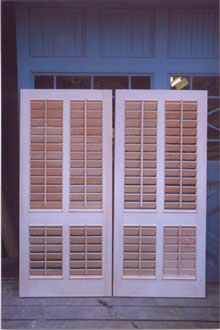
We know you woodworkers may not be completely up to speed on the latest in interior décor, so here’s a news flash: shutters are in (check the latest Martha Stewart Magazine).
That trend has been a real plus for Phil Czak, the only professional shutter builder in Maine. Since he started building them about six years ago, he hasn’t been able to stop. He’s developed a whole range of shutter styles, both exterior and interior.
It started like all good small businesses: at the bank. In this case, however, Phil was a cabinetmaker doing some work for the mega-bank and credit card company, MBA. Part of the bank’s décor included interior shutters and the company that made them couldn’t complete the project for some reason. So the bank asked Phil if he could handle it and “whenever they do anything, it’s ‘get it done today and we would have liked it yesterday,'” he says.
So he built the shutters, and then he build some more. Soon people were requesting him to do more and more shutters and, since they were easier than cabinetwork and he was getting good at it, he decided to switch his business to shutter work. About a year into it, he started getting requests for exterior shutters, so he expanded his repertoire.
Somewhere along the way he found a tool, a Festo Louver Groover (yes, that’s really the name), which cut the mortises for the louvers of the shutters. The tool can be adjusted to any angle for the mortise and any width for the louvers. The company doesn’t make the tool anymore, so Phil really babies his machine. It’s the perfect tool for the work he does. He has also built specialized jigs over the years that speed up the work.
So what are the particulars of building shutters? First off, there are shutters that have moveable louvers and fixed louvers. The former tend to be interior shutters and the latter are for the exterior. While Phil says shutters are easier to build than cabinets-because there are a lot of repetitive aspects in every shutter project-they can be pretty involved. “I once figured there’s something like 200 parts, on average, on each shutter, counting the little pins,” says Phil.
With movable shutters, Phil puts the louvers on nylon pins that set in nylon washers in the rails “so there’s never any chance of the wood rubbing on wood.” For fixed louver shutters, he uses dowels and wet system epoxy. The epoxy is the kind they use in boat building and is pretty near unbreakable. He says in the old days, the shutters were held together with mortise and tenon joints and a few pins. Some of those, over the years, get a droopy look to them as the wood moves and everything loosens up. Still, he says, he’s seen some well-made shutters that have lasted 150 years. “You’ve probably seen shutters on people’s houses that are 100 years old,” says Phil, “and they’re still there. So a shutter that is well made and painted should last 75-100 years.”
Almost all of his shutters are made of pine and destined to be painted. He’s done a few projects that call for mahogany shutters or cherry shutters, but for the most part, almost all shutters are painted. While they are predominately pine, Phil makes the louvers out of poplar because it’s tough and takes paint better than pine. He also always insists on brass eyelets for the moveable shutters, even though they are harder to install and cost more. They give the shutters a better look, are rust proof and last longer than the staples he sees in other shutters.
– Bob Filipczak





